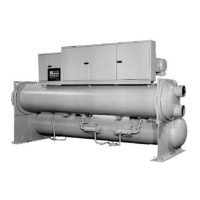4 PFS 155C - 315C OM 135
Alarm
The alarm light on the MicroTech control panel will be illuminated when any alarm condition exists.
Unless the alarm condition affects both compressors, the remaining compressor will operate as
required. Refer to the control section of this manual for additional information.
Start-up
If none of the above “off” conditions are true, the MicroTech controller will initiate a start sequence
and energize the chilled water pump output relay. If flow is not proven within 15 seconds, the alarm
output will be turned on and the keypad display will be No Evap Flow. When evap flow is confirmed,
the controller will sample the chilled water temperature and compare it against the Leaving Chilled
Water Setpoint and the Start-up Delta Temperature, which have been programmed into the controller’s
memory. If the leaving chilled water temperature is above the Leaving Chilled Water Setpoint plus the
adjustable Start-up Delta Temperature (which is defined outside of the control band), the controller
will then start the condenser pump. The same time and alarm conditions exist for the condenser flow.
The compressor with the lowest number of starts will be the lead compressor. The controller will open
the electronic expansion valves to regulate the pressure difference between the evaporator and the
condenser by pulling the evaporator pressure low once the compressor starts. The controller will start
the lead compressor and energize the compressor suction injection and motor cooling solenoid valves.
Liquid injection is energized through the auxiliary starter contacts. The lead compressor will increase
capacity by staging up according to the chilled water leaving evap setpoint. The lead compressor will
stage to 100% capacity before starting the lag compressor. If additional cooling capacity is required,
the controller will energize the lag compressor and stage it up according to setpoint. The compressors
capacity control solenoids will automatically be controlled as required to meet the cooling needs of
the system.
The electronic expansion valves are operated by the MicroTech controller through adaptive control
strategies (use of different system temperatures and pressures) to maintain desired refrigerant control
to the evaporator at all conditions.
Condenser Control
The condenser pump will be started in conjunction with the above logic to provide condenser water
flow. The minimum entering condenser water temperature for full load air conditioning duty shall be
65°F with nominal cooling tower water flow of 3 GPM. When condenser water temperatures are lower
and or chiller load is less than 100%, the condenser water flow or entering condenser water
temperature must be controlled to maintain satisfactory operating refrigerant pressures. The
MicroTech controller can control condenser water entering temperature by a condenser water bypass
valve based upon entering condenser water temperature. It can also control condenser water flow by
a flow control valve based upon condenser pressure. When using a flow control valve, a minimum
water flow through the condenser must be maintained. This minimum water flow is based upon
system conditions and can vary with each installation.
Shutdown
As the system chilled water requirements lessen, the compressors will be unloaded. As the system
load continues to drop, the lag compressor (compressor with the most run hours) will be stopped. A
continuing load reduction will start the hot gas option or the chiller can shut down on the shut down
delta setpoint below the control band.
Hot gas control will allow the unit to maintain minimum operating parameters if proper condenser
control is available. This type of control is standard and selectable from the keypad. If hot gas
control is not selected, the unit will shut down on the shut down delta setpoint. This feature can be
used to minimize chiller run time under light load conditions.
The condenser water pump will be stopped upon chiller shutdown and the chilled water pump output
relay will remain energized until the time schedule’s “on” time expires, the remote stop switch is
opened, the system switch is moved to the stop position, or a separate communications panel such as
the Chiller System Controller or an Open Protocol interface disables the chiller.

